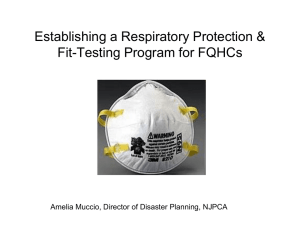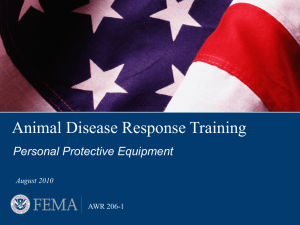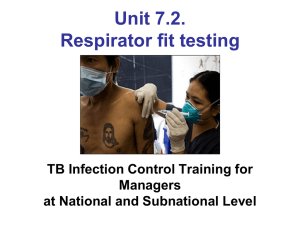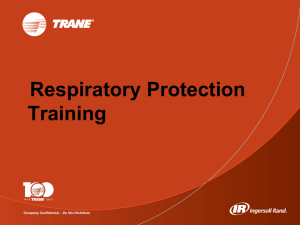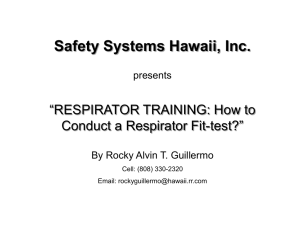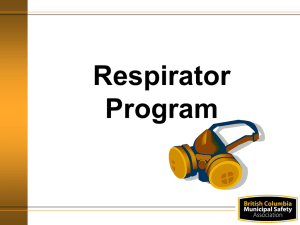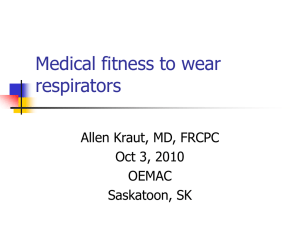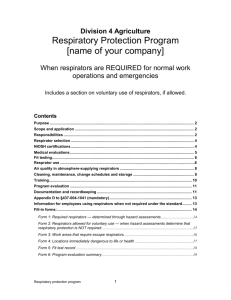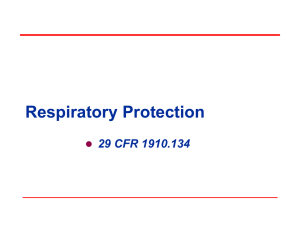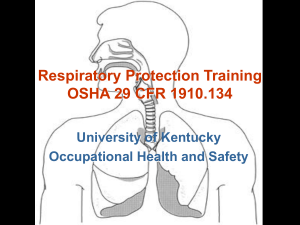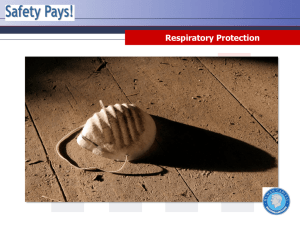Major Requirements of OSHA Respiratory Protection Standard 29
advertisement
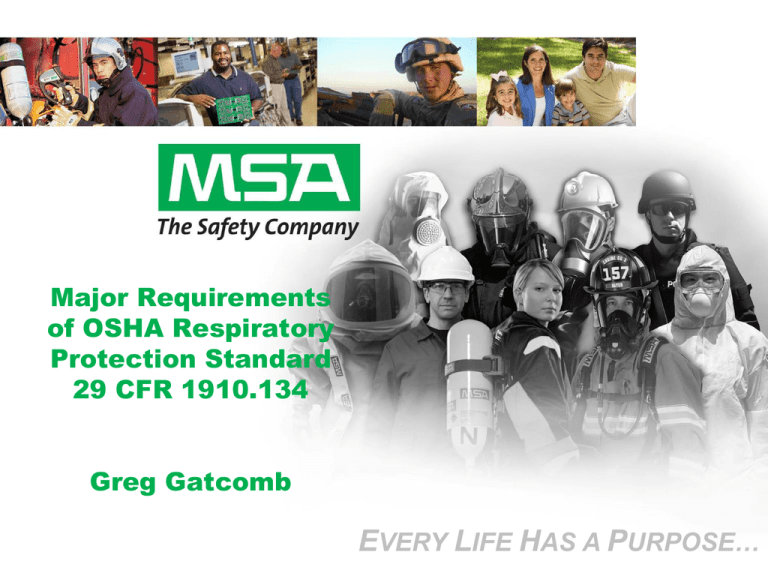
Major Requirements of OSHA Respiratory Protection Standard 29 CFR 1910.134 Greg Gatcomb EVERY LIFE HAS A PURPOSE… 29 CFR 1910 This standard applies to: General Industry (Part 1910), Shipyards (Part 1915), Marine Terminals (Part 1917), Longshoring (Part 1918), and Construction (Part 1926). Organization of Standard (a) (b) (c) (d) (e) (f) (g) (h) Permissible practice Definitions Respirator program Selection of respirators Medical evaluation Fit testing Use of respirators Maintenance and care (i) Breathing air quality and use (j) Identification of filters, cartridges, and canisters (k) Training and information (l) Program evaluation (m) Recordkeeping Permissible Practice (a) (1) The primary means to control occupational diseases caused by breathing contaminated air is through the use of feasible engineering controls, such as enclosures, confinement of operations, ventilation, or substitution of less toxic materials. When effective engineering controls are not feasible, or while they are being instituted, appropriate respirators shall be used pursuant to this standard. Definitions (b) This section includes definitions of important terms – Air purifying, Assigned protection factor (APF), Air supplied respirator, Canister or cartridge, Demand respirator, Emergency situation, Employee exposure, End of life service indicator (ELSI), Escape only, Filter or air purifying element, Filtering facepiece, Fit factor, Fit test, Helmet, Hood, Interior structural fire fighting, Loose fitting facepiece, Maximum use concentration…… Respiratory Protection Program (c) (1) Must develop a written program with worksitespecific procedures when respirators are necessary or required by the employer Voluntary Respirator use-make employee aware of information in Appendix D and consult flow chart for other requirements Must update program as necessary to reflect changes in workplace conditions that affect respirator use Respiratory Protection Program (c) (3) The employer shall designate a program administrator who is qualified by appropriate training or experience to administer or oversee the program and conduct the required program evaluations for effectiveness. (4)The employer shall provide respirators, training, and medical evaluations at no cost to the employee. Note: OSHA has prepared a Small Entity Compliance Guide that contains criteria for selection of a program administrator and a sample program. Selection of Respirators (d) (1) General requirements – (i) Employer must select and provide an appropriate respirator based on the respiratory hazards to which the worker is exposed and workplace and user factors that affect respirator performance and reliability. – (ii) Select a NIOSH-certified respirator that shall be used in compliance with the conditions of its certification. – (iii) Identify and evaluate the respiratory hazards in the workplace, including a reasonable estimate of employee exposures and identification of the contaminant’s chemical state and physical form. Where exposure cannot be identified or reasonably estimated, the atmosphere shall be considered Immediately Dangerous to Life or Health (IDLH) Selection of Respirators (d) (2) Respirators for IDLH atmospheres – (i) (A) Full Facepiece Pressure Demand SCBA certified by NIOSH for a minimum service life of 30 minutes – (i) (B) Combination Full Facepiece Pressure Demand SAR with Auxiliary Self-Contained Air Supply Selection of Respirators (d) (3) Respirators for atmospheres that are not IDLH – (i) (A) Assigned Protection Factors (APFs) Employers must use the APF’s listed in Table 1 to select a respirator that meets or exceeds the required level of protection. TABLE 1 – ASSIGNED PROTECTION FACTORS5 Respirator Type1, Quarter Mask Half Mask Full Face Helmet/Hood LooseFitting 5 310 50 ----------------- ----------------- ------------------- 50 1,000 425/1,000 25 SAR Demand Continuous Flow Pressure Demand/ other (+) pressure ------------------------------------------------------- 10 50 50 50 1,000 1,000 SCBA Demand Pressure Demand/ other (+) pressure ------------------------------------- 10 ----------------- 50 10,000 2 Air Purifying PAPR --------------------- ------------------425/1,000 25 --------------------------------------- 50 10,000 -------------------------------------- Selection of Respirators (d) (3) (B) Maximum Use Concentration – (1) The employer must select a respirator that maintains exposure to the hazardous substance, when measured outside the respirator, at or below the MUC. – (2) Employers must not apply MUCs to conditions that are IDLH; must use SCBA or SAR with Escape cylinder – (3) When the calculated MUC exceeds the IDLH level for a hazardous substance, or the performance limits of the cartridge or canister, then employers must set the maximum MUC at that lower limit Maximum Use Concentration Example What is the MUC for an employee wearing a halfmask air purifying respirator (APF=10) in an atmosphere of sulfur dioxide gas (PEL=5 ppm)? MUC = APF x OSHA Exposure Limit MUC = 10 x 5 ppm = 50 ppm Note that this calculated value does not exceed the IDLH level for sulfur dioxide (100 ppm), so that the MUC for this example would be 50 ppm. Selection of Respirators (d) (3) Respirators for atmospheres that are not IDLH – (ii) (3) The respirator selected shall be appropriate for the chemical state and physical form of the contaminant. Selection of Respirators (d) (3) Respirators for atmospheres that are not IDLH – (iii) For protection against gases and vapors, the employer shall provide: (B) An air purifying respirator – (1) Provided that the respirator is equipped with an end of service life indicator (ELSI) certified by NIOSH for the contaminant – (2) If there is no ELSI appropriate for workplace conditions, the employer implements a change schedule for canisters and cartridges that will ensure they are changed before the end of their service life. Selection of Respirators (d) (3) Respirators for atmospheres that are not IDLH – (iv) For protection against particulates the employer shall provide An air purifying respirator equipped with a HEPA filter certified by NIOSH under 30 CFR Part II or with filters certified for particulates under 42 CFR Part 84(N,R,P) or An air purifying respirator equipped with any filter certified for particulates by NIOSH for contaminants consisting primarily of particles of at least 2 micrometers. Choose Filter Efficiency (95%, 99%, 99.97%) YES YES Will Filter Be Used More Than 8 Hours? Use P Series Filter Does the Aerosol Contain Oil? NO Use R Series Filter NO Use N, R, or P Series Filter Medical Evaluation (e) (1) General. The employer must provide a medical evaluation to determine employees ability to use a respirator before fit testing and use. (2) Medical evaluation procedures. – (i) The employer must identify a physician or other licensed health care professional (PLHCP) to perform medical evaluations using a medical questionnaire or an initial medical evaluation that obtains the same information. Fit Testing (f) (1) All employees using a negative or positive pressure tight fitting facepiece respirator must pass an appropriate qualitative fit test (QLFT) or quantitative fit test (QNFT). (2)Fit testing is required prior to initial use, whenever a different respirator facepiece is used and at least annually thereafter. (3) Additional fit test is required when the employee reports, or the employer, PLHCP, supervisor, or program administrator makes visual observations of changes in the employees physical condition that could affect respirator fit ( e.g., facial scarring, dental changes, cosmetic surgery or change in body weight). Fit Testing (f) (5) The fit test shall be administered using an OSHA-accepted QLFT or QNFT protocol as contained in mandatory appendix A. – QLFT Protocols: Isoamyl acetate Saccharin Bitrex Irritant smoke – QNFT Protocols: Generated Aerosol (corn oil, salt, DEHP) Condensation Nuclei Counter (PortaCount) Controlled Negative Pressure (Dynatech FitTester 3000) Controlled Negative Pressure (CNP) REDON Fit Testing (f) (6) QLFT may only be used to fit negative pressure air purifying respirators that must achieve a fit factor or 100 or less. Fit Testing (f) (7) If the fit factor, as determined through an OSHA-accepted QNFT protocol is equal to or greater than 100 for tight fitting half facepieces or greater than 500 for tight fitting full facepieces, the QNFT has passed with that respirator. Fit Factor A quantitative estimate of the fit of a particular respirator to a specific individual, and typically estimates the ratio: Concentration of a substance in ambient air Concentration inside the respirator when worn Use of respirators (g) (1) Facepiece seal protection – (i) The employer shall not permit respirators with tight fitting facepieces to be worn by employees who have: (A) Facial hair that comes between the sealing surface of the facepiece and the face or that interferes with valve function. (B) Personal protective equipment shall be worn in such a manner that does not interfere with the seal of the facepiece to the face of the user. Use of Respirators (g) (iii) Employees shall perform a user seal check each time they put on a tight-fitting respirator using the procedures in mandatory Appendix B1 or equally effective manufacturer’s procedures. Maintenance and Care of Respirators (h) (1) The employer shall ensure that the respirators are cleaned and disinfected using the procedures in Appendix B-2 or equally effective procedures recommended by the respirator manufacturer. – (i) Respirators for the exclusive use of an employee shall be cleaned and disinfected as often as necessary to be maintained in a sanitary condition. – (ii) Respirators issued to more than one employee shall be cleaned and disinfected before being worn by different individuals. – (iii) Emergency use respirators shall be cleaned and disinfected after each use – (iv) Respirators used in fit testing and training shall be cleaned and disinfected after each use Breathing Air Quality and Use (i) (1) (ii)Compressed breathing air must meet at least the requirements for Type 1 - Grade D breathing air described in ANSI/CGA G-7.11989: – Oxygen content (v/v) of 19.5 - 23.5% – Hydrocarbon (condensed) content of 5 milligrams per cubic meter (mg/m3) of air or less – CO content of 10 parts per million (ppm) or less – CO2 content of 1,000 ppm or less – Lack of noticeable odor Identification of filters, cartridges and canisters (j) All filters, cartridges and canisters used in the workplace must be labeled and color coded with the NIOSH approval label and that the label is not removed and must remain legible. Training and Information (k) Employers must provide effective training to employees who are required to use respirators. The training must be comprehensive, understandable and recur annually and more often if necessary. Training and Information (k) (1) Employees who are required to use respirators must be trained such that they can demonstrate knowledge of at least: – (i) why the respirator is necessary and how improper fit, use, or maintenance can compromise its protective effect – (ii) limitations and capabilities of the respirator – (iii) effective use in emergency situations – (iv)how to inspect, put on and remove, use and check the seals – (v) maintenance and storage – (vi) recognition of medical signs and symptoms that may limit or prevent effective use Training and Information (k) (5)Retraining is required annually, and when: – (i) changes in the workplace or type of respirator render previous training obsolete – (ii) there are inadequacies in the employee’s knowledge or use – (iii) any other situation arises in which retraining appears necessary Program Evaluation (l) (1) Must conduct evaluations of the workplace as necessary to ensure effective implementation of the program (2) Must regularly consult employees required to use respirators to assess their views on program effectiveness and to identify and correct any problems – factors to be assessed include, but are not limited to: (i) respirator fit (including effect on workplace performance) (ii) appropriate selection (iii) proper use (iv) proper maintenance Recordkeeping (m) (1) Records of medical evaluations must be retained and made available per 29 CFR 1910.1020 (2) A record of fit tests must be established and retained until the next fit test is administered (3) A written copy of the current program must be retained (4) Written materials required to be retained must be made available upon request to affected employees and OSHA Commonly missed Under Use of Respirators Section Procedures for IDLH environments 1 outside,communication,rescue Procedures for Interior Structural Firefighting 2 in 2 out rule Questions
